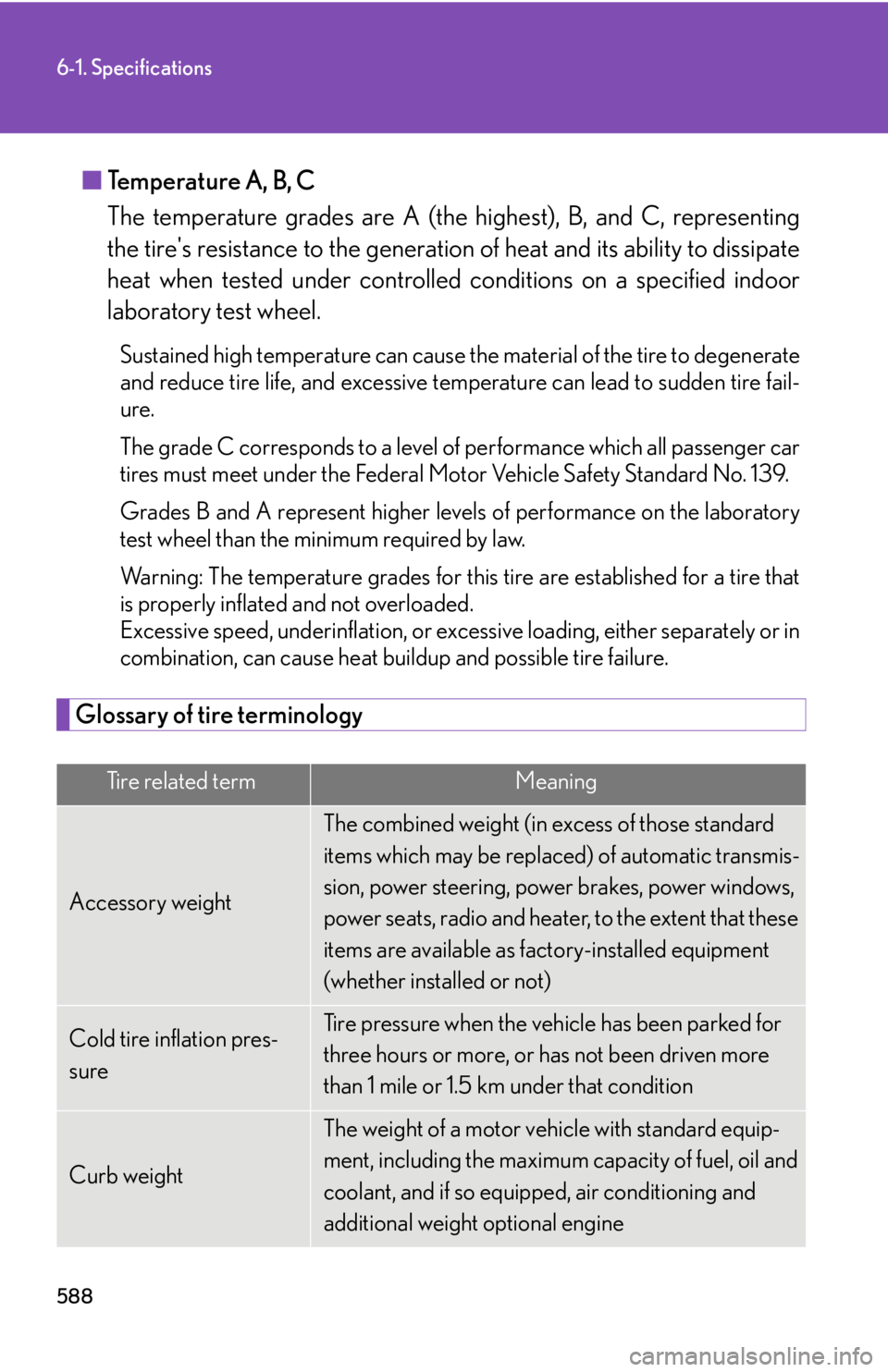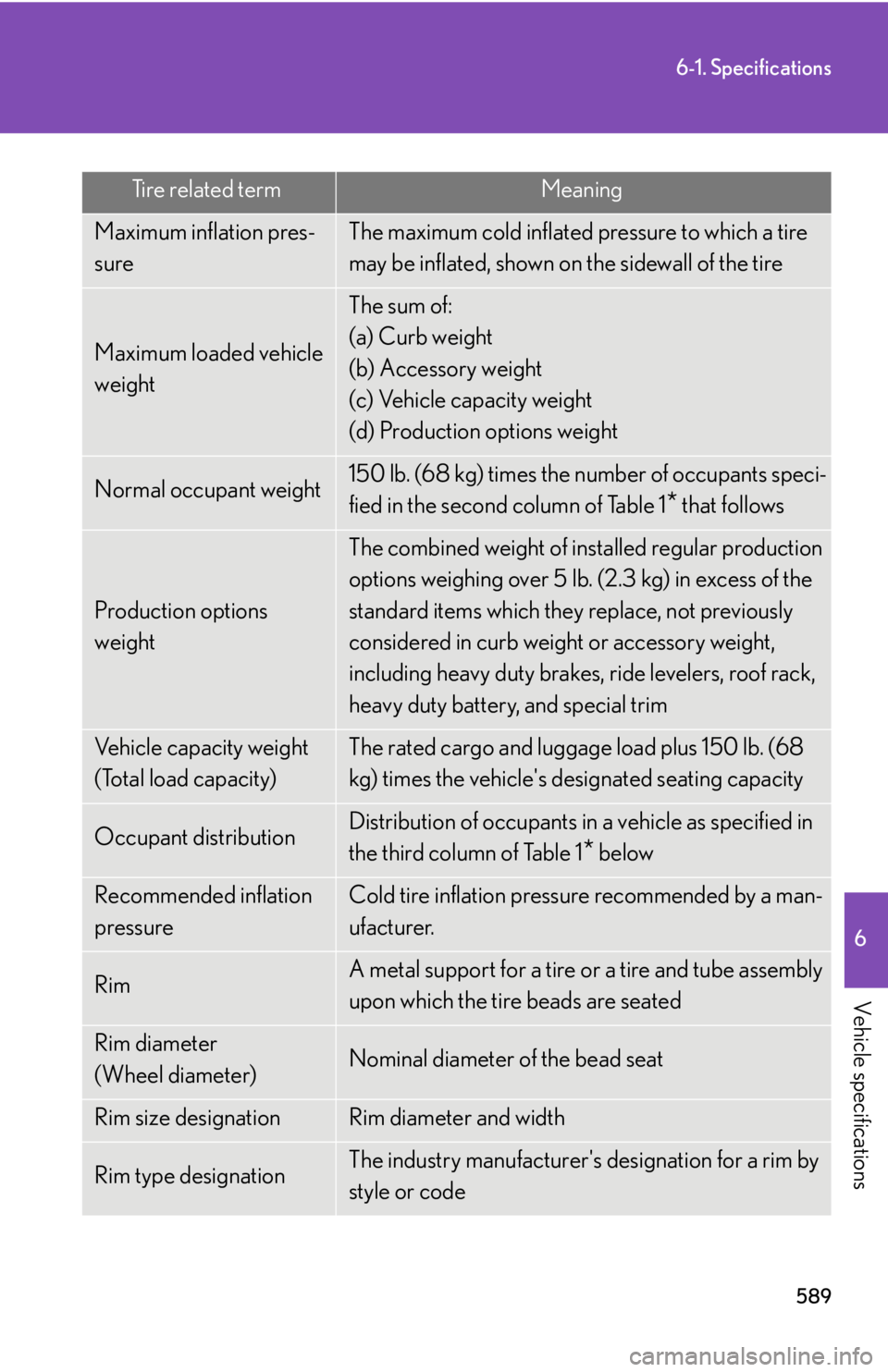flat tire Lexus IS250C 2012 Instrument cluster / LEXUS 2012 IS250C,IS350C (OM53A62U) Service Manual
[x] Cancel search | Manufacturer: LEXUS, Model Year: 2012, Model line: IS250C, Model: Lexus IS250C 2012Pages: 632, PDF Size: 6.77 MB
Page 572 of 632

572
6-1. Specifications
Steering
Tires and wheelsTy p e A
Free playLess than 1.2 in. (30 mm)
Ti r e s i z e
Front tires: 225/45R17 90W
Rear tires: 245/45R17 95W
Spare tire: T125/70D17 98M
Front and rear tire inflation pres-
sure
(Recommended cold tire inflation
pressure)
Driving under normal conditions
Front:
35 psi (240 kPa, 2.4 kgf/cm
2 or bar)*
Rear:
38 psi (260 kPa, 2.6 kgf/cm
2 or bar)*
Spare:
60 psi (420 kPa, 4.2 kgf/cm
2 or bar)
*: When driving at high speeds above 100 mph (160 km/h), in countries where such speeds
are permitted by law, add 4.5 psi (30 kPa, 0.3
kgf/cm
2 or bar) to the front tires and rear
tires. Never exceed the maximum cold tire
inflation pressure indicated on the tire side-
wall.
Wheel size17 8J, 17 4T (spare)
Wheel nut torque76 ft•lbf (103 N•m, 10.5 kgf•m)
Page 573 of 632

573
6-1. Specifications
6
Vehicle specifications
Type B
Ti r e s i z e
Front tires: 225/45R17 91V
Rear tires: 245/45R17 95V
Spare tire: T125/70D17 98M
Front and rear tire inflation pres-
sure
(Recommended cold tire inflation
pressure)
Driving under normal conditionsFront:
35 psi (240 kPa, 2.4 kgf/cm
2 or bar)*
Rear:
38 psi (260 kPa, 2.6 kgf/cm
2 or bar)*
Spare:
60 psi (420 kPa, 4.2 kgf/cm
2 or bar)
*: When driving at high speeds above 100 mph (160 km/h), in countries where such speeds
are permitted by law, add 7.2 psi (50 kPa, 0.5
kgf/cm
2 or bar) to the front tires and rear
tires. Never exceed the maximum cold tire
inflation pressure indicated on the tire side-
wall.
Wheel size17 8J, 17 4T (spare)
Wheel nut torque76 ft•lbf (103 N•m, 10.5 kgf•m)
Page 574 of 632

574
6-1. Specifications
Ty p e C
Ti r e s i z e
Front tires: 225/40R18 88Y
Rear tires: 255/40R18 95Y
Spare tire: T145/70D17 106M
Front and rear tire inflation pres-
sure
(Recommended cold tire inflation
pressure)
Driving under normal conditions Front:
35 psi (240 kPa, 2.4 kgf/cm
2 or bar)*
Rear:
38 psi (260 kPa, 2.6 kgf/cm
2 or bar)*
Spare:
60 psi (420 kPa, 4.2 kgf/cm
2 or bar)
*: When driving at high speeds above 100 mph (160 km/h), in countries where such speeds
are permitted by law, add 7.2 psi (50 kPa, 0.5
kgf/cm
2 or bar) to the front tires and rear
tires. Never exceed the maximum cold tire
inflation pressure indicated on the tire side-
wall.
Wheel size
Front wheels: 18 8J
Rear wheels: 18 8 1 /2J
Spare wheel: 17 4T
Wheel nut torque76 ft•lbf (103 N•m, 10.5 kgf•m)
Page 575 of 632

575
6-1. Specifications
6
Vehicle specifications
Type D
Ti r e s i z e
Front tires: 225/40R18 88W
Rear tires: 255/40R18 95W
Spare tire: T145/70D17 106M
Front and rear tire inflation pres-
sure
(Recommended cold tire inflation
pressure)
Driving under normal conditionsFront:
35 psi (240 kPa, 2.4 kgf/cm
2 or bar)*
Rear:
38 psi (260 kPa, 2.6 kgf/cm
2 or bar)*
Spare:
60 psi (420 kPa, 4.2 kgf/cm
2 or bar)
*: When driving at high speeds above 100 mph (160 km/h), in countries where such speeds
are permitted by law, add 7.2 psi (50 kPa, 0.5
kgf/cm
2 or bar) to the front tires and rear
tires. Never exceed the maximum cold tire
inflation pressure indicated on the tire side-
wall.
Wheel size
Front wheels: 18 8J
Rear wheels: 18 8 1 /2J
Spare wheel: 17 4T
Wheel nut torque76 ft•lbf (103 N•m, 10.5 kgf•m)
Page 576 of 632

576
6-1. Specifications
Ty p e E
Ti r e s i z eFront tires: 225/40RF18 88V
Rear tires: 255/40RF18 95V
Front and rear tire inflation pres-
sure
(Recommended cold tire inflation
pressure)
Driving under normal conditions Front:
35 psi (240 kPa, 2.4 kgf/cm
2 or bar)*
Rear:
38 psi (260 kPa, 2.6 kgf/cm
2 or bar)*
*: When driving at high speeds above 100 mph (160 km/h), in countries where such speeds
are permitted by law, add 11.7 psi (80 kPa,
0.8 kgf/cm
2 or bar) to the front tires and rear
tires. Never exceed the maximum cold tire
inflation pressure indicated on the tire side-
wall.
Wheel sizeFront wheels: 18 8J
Rear wheels: 18 8 1 /2J
Wheel nut torque76 ft•lbf (103 N•m, 10.5 kgf•m)
Page 583 of 632

583
6-1. Specifications
6
Vehicle specifications
Radial tires or bias-ply tires
A radial tire has “RADIAL” on the sidewall. A tire not marked “RADIAL” is
a bias-ply tire.
TUBELESS or TUBE TYPE
A tubeless tire does not have a tube and air is directly filled in the tire. A
tube type tire has a tube inside the ti re and the tube maintains the air pres-
sure.
Load limit at maximum cold tire inflation pressure ( P. 443)
Maximum cold tire inflation pressure ( P. 5 7 2 )
This means the pressure to which a tire may be inflated.
Uniform tire quality grading
For details, see “Uniform Tire Quality Grading” that follows.
Summer tire or all season tire (P. 443)
An all season tire has “M+S” on the sidewall. A tire not marked “M+S” is a
summer tire.
“TEMPORARY USE ONLY” ( P. 523)
A compact spare tire is identified by the phrase “TEMPORARY USE
ONLY” molded into its sidewall. This tire is designed for temporary
emergency use only.
Run-flat tire (RFT) or standard tire ( P. 585)
This vehicle can be equipped with ei ther run-flat tires (RFT) or standard
tires. A “RFT” or “DSST” mark is molded on the sidewall of the run-flat
tire.
Page 585 of 632

585
6-1. Specifications
6
Vehicle specifications
Tire size■ Typical tire size information
The illustration indicates typical
tire size.
Ti r e u s e
(P = Passenger car,
T = Temporary use)
Section width (millimeters)
Aspect ratio
(tire height to section width)
Tire construction code
(R = Radial, D = Diagonal)
Wheel diameter (inches)
Load index (2 or 3 digits)
Speed symbol
(alphabet with one letter)
Run-flat tire code
Page 588 of 632

588
6-1. Specifications
■Temperature A, B, C
The temperature grades are A (the highest), B, and C, representing
the tire's resistance to the generation of heat and its ability to dissipate
heat when tested under controlled conditions on a specified indoor
laboratory test wheel.
Sustained high temperature can cause the material of the tire to degenerate
and reduce tire life, and excessive temperature can lead to sudden tire fail-
ure.
The grade C corresponds to a level of performance which all passenger car
tires must meet under the Federal Mo tor Vehicle Safety Standard No. 139.
Grades B and A represent higher levels of performance on the laboratory
test wheel than the minimum required by law.
Warning: The temperature grades for this tire are established for a tire that
is properly inflated and not overloaded.
Excessive speed, underinflation, or excess ive loading, either separately or in
combination, can cause heat buildup and possible tire failure.
Glossary of tire terminology
Tire related termMeaning
Accessory weight
The combined weight (in excess of those standard
items which may be replaced) of automatic transmis-
sion, power steering, power brakes, power windows,
power seats, radio and heater, to the extent that these
items are available as factory-installed equipment
(whether installed or not)
Cold tire inflation pres-
sureTire pressure when the vehicle has been parked for
three hours or more, or has not been driven more
than 1 mile or 1.5 km under that condition
Curb weight
The weight of a motor vehicle with standard equip-
ment, including the maximum capacity of fuel, oil and
coolant, and if so equipp ed, air conditioning and
additional weight optional engine
Page 589 of 632

589
6-1. Specifications
6
Vehicle specifications
Maximum inflation pres-
sureThe maximum cold inflated pressure to which a tire
may be inflated, shown on the sidewall of the tire
Maximum loaded vehicle
weight
The sum of:
(a) Curb weight
(b) Accessory weight
(c) Vehicle capacity weight
(d) Production options weight
Normal occupant weight150 lb. (68 kg) times the number of occupants speci-
fied in the second column of Table 1
* that follows
Production options
weight
The combined weight of installed regular production
options weighing over 5 lb. (2.3 kg) in excess of the
standard items which they replace, not previously
considered in curb weight or accessory weight,
including heavy duty brakes, ride levelers, roof rack,
heavy duty battery, and special trim
Vehicle capacity weight
(Total load capacity)The rated cargo and luggage load plus 150 lb. (68
kg) times the vehicle's designated seating capacity
Occupant distributionDistribution of occupants in a vehicle as specified in
the third column of Table 1
* below
Recommended inflation
pressureCold tire inflation pressure recommended by a man-
ufacturer.
RimA metal support for a tire or a tire and tube assembly
upon which the tire beads are seated
Rim diameter
(Wheel diameter)Nominal diameter of the bead seat
Rim size designationRim diameter and width
Rim type designationThe industry manufacturer's designation for a rim by
style or code
Tire related termMeaning
Page 590 of 632

590
6-1. Specifications
Rim widthNominal distance between rim flanges
Vehicle maximum load on
the tireThe load on an individual tire that is determined by
distributing to each axle its share of the maximum
loaded vehicle weight, and dividing by two
Vehicle normal load on
the tire
The load on an individual tire that is determined by
distributing to each axle its share of curb weight,
accessory weight, and normal occupant weight (dis-
tributed in accordance with Table 1
* below), and
dividing by two
We a t h e r s i d eThe surface area of the rim not covered by the
inflated tire
Tire related termMeaning